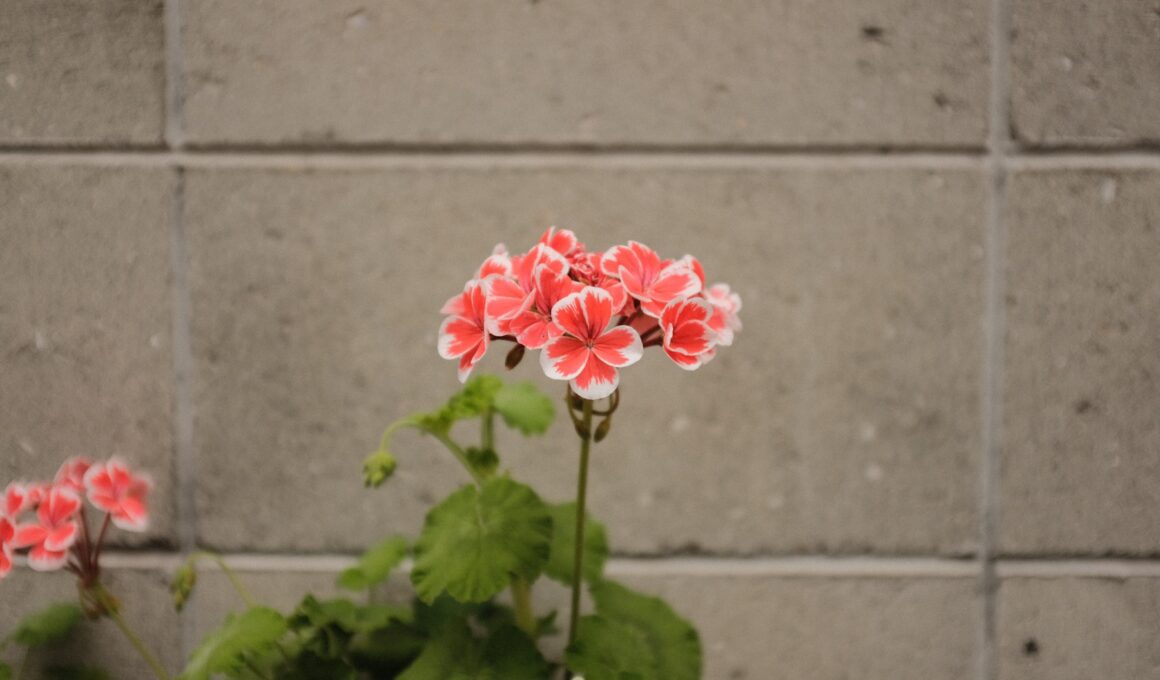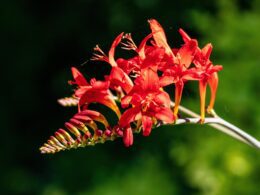Do you have geraniums in your garden? If so, you may be wondering whether or not to cut them back every year.
There is an ongoing debate among gardeners about the benefits and drawbacks of pruning geraniums, and it can be confusing to know what to do. However, understanding the different types of geraniums and the best practices for pruning can help you maintain healthy plants and ensure a beautiful garden.
Geraniums are popular plants that come in many varieties, from the common garden geranium to the scented-leaf geranium and the ivy-leaved geranium. They are known for their vibrant colors and long-lasting blooms, making them a favorite among gardeners.
However, when it comes to pruning, opinions are divided. Some gardeners believe that pruning is necessary to promote new growth and prevent disease, while others argue that it can harm the plant and reduce its lifespan.
So, what should you do? Read on to learn more about the debate and find out the best practices for pruning geraniums.
Understanding the Debate Over Pruning Geraniums
You may be interested in understanding the ongoing debate surrounding the pruning of geraniums. Some people believe that cutting them back every year is essential to promote growth and prevent disease, while others argue that this practice is unnecessary and can actually harm the plant.
So, what are the pros and cons of pruning geraniums, and what do the experts say?
On the one hand, those in favor of annual pruning suggest that it can stimulate new growth and prevent the plant from becoming too woody. Additionally, regular pruning can help to control the size and shape of the plant, making it easier to manage and more aesthetically pleasing. However, opponents of this practice argue that it can remove too much of the plant’s foliage, leaving it vulnerable to disease and pest infestations.
So, who is right? According to experts, it depends on the specific variety of geranium and the conditions in which it is grown. Some types of geraniums may benefit from annual pruning, while others may not require it at all. Ultimately, the decision to prune or not to prune should be based on the individual needs of the plant, rather than a one-size-fits-all approach.
Types of Geraniums
When it comes to types of geraniums, there are a few key points to consider. First off, different types of geraniums have different growth habits, so it’s important to understand what kind of plant you’re dealing with.
Secondly, pruning considerations will vary depending on the type of geranium you have, so it’s important to know what kind of care your plant needs.
Overall, understanding the differences in growth habits and pruning considerations for different types of geraniums will help you keep your plant healthy and thriving.
Differences in Growth Habits
The growth habits of geraniums vary, and this means they should be managed differently depending on the type. Some geraniums have a stunted growth and a bushy appearance. This type of geranium doesn’t need to be cut back every year. Instead, you should only remove dead flowers and leaves to encourage new growth and maintain its compact shape.
On the other hand, some geraniums have tall and leggy growth with sparse foliage. This type of geranium requires annual pruning to promote bushiness and prevent legginess. Cut back one-third of the plant’s growth in the early spring to encourage new growth and a fuller appearance.
By understanding the differences in growth habits, you can properly manage your geraniums and keep them healthy and thriving.
Considerations for Pruning
Pruning your geraniums is crucial for maintaining their healthy and beautiful appearance, so it’s important to consider the best methods for your specific type of plant.
When it comes to the frequency of pruning, it depends on the growth habit of your geraniums. Some varieties, such as ivy geraniums, have a trailing growth habit and require more frequent pruning to keep them from becoming too leggy.
On the other hand, some varieties, such as zonal geraniums, have a more compact growth habit and require less frequent pruning.
In addition to considering the growth habit of your geraniums, it’s important to use the proper pruning tools. Sharp, clean shears or scissors are best for making clean cuts that will promote healthy growth.
Avoid using dull or dirty tools, as they can damage the plant and introduce disease. By taking the time to consider the pruning frequency and using proper tools, you can help ensure that your geraniums stay healthy and beautiful year after year.
Are Perennial Geraniums Supposed to be Cut Back Every Year?
Are perennial geraniums supposed to be cut back every year? The geranium perennial lifespan can be prolonged by cutting back the plant after blooming. Trimming the stems will encourage new growth and prevent the plant from becoming leggy. However, it is not mandatory to cut them back annually. Some gardeners choose to leave the faded foliage until spring for added winter interest.
Best Practices for Pruning Geraniums
To keep your geraniums healthy and looking their best, it’s recommended that you give them a proper trim. Pruning techniques will depend on the type of geranium you have, but generally, you’ll want to remove any dead, yellowing, or damaged leaves and stems.
You can do this any time of year, but the best time to do a more thorough pruning is in the spring, before new growth appears. When pruning your geraniums, it’s important to use clean, sharp tools to prevent any damage or disease.
Make sure to cut just above a leaf node, which is where new growth will occur. You can also pinch off the tips of the stems to encourage bushier growth. Don’t be afraid to prune your geraniums back quite a bit, as this will stimulate new growth and help keep the plant full and healthy.
Overall, pruning your geraniums is a simple but important task that will help keep your plants looking their best. By removing any dead or damaged growth and encouraging new growth, you’ll help ensure that your geraniums thrive. And with the right pruning techniques and seasonal timing, you’ll be able to enjoy beautiful, healthy geraniums year after year.
Maintaining Healthy Geraniums
As we mentioned earlier, pruning geraniums is an essential best practice to ensure healthy and vibrant blooms. However, maintenance goes beyond just pruning. To keep your geraniums healthy, you need to ensure they are getting the right amount of water and soil pH level.
Watering frequency is a crucial factor in maintaining healthy geraniums. Overwatering can cause root rot, which can ultimately kill your plant. Therefore, you need to be careful not to water your geraniums too frequently. On the other hand, underwatering can cause your plant to wilt and eventually die. It’s essential to find the right balance between these two extremes to keep your geraniums healthy.
The soil pH level is another critical factor in maintaining healthy geraniums. Geraniums thrive in slightly acidic soil. Therefore, it’s essential to test your soil’s pH level regularly and ensure it’s within the range of 6.0 to 7.5. If the pH level is too high or too low, your geraniums may struggle to absorb nutrients, leading to stunted growth and poor blooms.
To summarize, pruning geraniums is essential, but it’s not the only factor in maintaining healthy plants. You need to ensure your geraniums are getting the right amount of water and soil pH level. With these factors in mind, you can ensure your geraniums thrive and produce beautiful blooms year after year.
Are you struggling to keep your geraniums healthy? Are your plants wilting or not producing blooms? Do you know how much water your geraniums need? Are you familiar with the ideal soil pH level for geraniums?
If you answered yes to any of these questions, keep reading to learn how to maintain healthy geraniums.
Conclusion: To Prune or Not to Prune?
You can imagine a vibrant geranium garden full of healthy blooms by learning how to maintain the right watering frequency and soil pH level. But what about pruning? Should you cut back your geraniums every year? The answer is not a simple yes or no. There are benefits and drawbacks to pruning your geraniums.
One benefit of pruning is that it can help promote new growth. By cutting back the stems, you encourage the plant to produce more branches, which can lead to more blooms. It can also help keep the plant from becoming too leggy and straggly. However, if you prune too heavily or at the wrong time of year, you could actually harm the plant and reduce the number of blooms it produces.
On the other hand, one drawback of pruning is that it can be time-consuming and labor-intensive. It’s important to use sharp, clean tools to avoid damaging the plant and to properly dispose of any diseased or damaged material. Additionally, some gardeners prefer the natural, wild look of unpruned geraniums. Ultimately, the decision to prune your geraniums should depend on your personal preferences and the specific needs of your plants.
Frequently Asked Questions
What is the best time of year to prune geraniums?
To keep your geraniums healthy and looking their best, it’s important to prune them regularly. The best time to do this is in the winter when they’re dormant and not actively growing. Winter pruning has many benefits, including promoting new growth in the spring, improving the overall shape of the plant, and removing any dead or diseased branches.
When shaping your geraniums, it’s important to use proper techniques to avoid damaging the plant. Start by removing any dead or damaged branches, then shape the plant by cutting back the tips of the remaining branches. With a little care and attention, your geraniums will thrive and provide you with beautiful blooms year after year.
How much should I prune my geraniums?
When it comes to pruning your geraniums, it’s important to understand their growth patterns and use the right techniques to keep them healthy and vibrant.
To start, remove any dead or damaged stems and leaves throughout the year.
When it’s time for a more significant pruning, wait until after the plant has finished flowering and then trim back up to one-third of the plant’s overall size. This will help encourage new growth and keep your geraniums looking their best.
Remember to use clean, sharp tools to avoid damaging the plant, and don’t be afraid to ask for help or guidance if you’re unsure about anything.
With the right care and attention, your geraniums will thrive year after year.
Can I use the cuttings from pruning to propagate new geranium plants?
Looking to propagate geraniums? One way to do so is by using cuttings from pruning. To ensure successful propagation, make sure to take cuttings that are at least 4 inches long and include a few leaves. Remove the lower leaves and dip the cut end in rooting hormone before planting in well-draining soil.
Keep the soil moist and the cutting in a warm, bright location. With proper care, your new geranium plant should start to grow roots within a few weeks.
When it comes to pruning techniques, it’s generally recommended to cut back geraniums by one-third in the spring to promote bushier growth and more blooms. But don’t worry, as long as you follow these tips, your geraniums will continue to thrive year after year.
What are some common diseases that can affect geraniums, and how can I prevent them?
Preventing geranium diseases is crucial to keeping your plants healthy and thriving. There are several tips and techniques you can use to prevent common geranium diseases.
First, make sure to give your plants adequate space and ventilation to prevent the buildup of moisture, which can lead to fungal diseases. Additionally, avoid over-watering and ensure proper drainage. When watering, try to avoid getting the leaves wet, as this can also contribute to disease development.
It’s also important to regularly inspect your plants for signs of disease or pests, such as yellowing leaves or white powdery residue. If you do spot an issue, act quickly to identify the problem and take appropriate measures to control it.
Common geranium pests include spider mites, aphids, and whiteflies, which can be controlled with insecticidal soap or neem oil. By following these tips and techniques, you can keep your geraniums healthy and free from disease.
Are there any specific tools I should use for pruning geraniums?
When it comes to pruning geraniums, there are a few essential tools you’ll need to have on hand. These include a sharp pair of pruning shears, gloves to protect your hands, and disinfectant to prevent the spread of diseases.
As for pruning techniques, it’s important to cut back any dead or diseased growth to promote healthy new growth. You can also pinch back the tips of the stems to encourage bushier growth. Remember to make clean cuts at a 45-degree angle to prevent damage to the plant.
By using the right equipment and techniques, you can help keep your geraniums healthy and thriving year after year.
Conclusion
So, should you cut back your geraniums every year? The answer is: it depends.
It depends on the type of geranium you have, your personal preferences, and the overall health of the plant. If you have a woody-stemmed geranium, pruning can help to promote new growth and maintain its shape. However, if you have a soft-stemmed geranium, pruning may not be necessary and could even harm the plant.
Ultimately, the decision to prune your geraniums every year should be based on careful consideration and observation of your plant’s needs. By following best practices for pruning and maintaining healthy geraniums, you can ensure that your plants will thrive for years to come.









